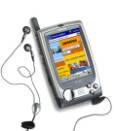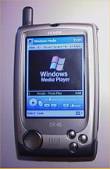|
|
Chris De Herrera's Windows CE Website |
|---|---|
About |
|
| By Chris De Herrera Copyright 1998-2007 All Rights Reserved A member of the Talksites Family of Websites Windows and
Windows CE are trademarks of
Microsoft All Trademarks are owned |
Siemens SX45 Review
By Mark Elliott,
Management Consultant and gadget phreak, UK.
Copyright 2001 Version 1.00 Revised 10/24/2001
[an error occurred while processing this directive]
A
New Milestone
|
|
The
Siemens site says “The
SX45 – a new milestone in today’s communication.”
This may be a milestone for Siemens, but I was surprised to
see they had chosen to adopt an established Pocket PC machine (the
Cassiopeia E125) for this package rather than use their technology
know-how to develop an iPaq beating device – now that would steal
the market. However, this is a pretty neat package – and it works
! Siemens
kindly handed out some of these machines at a recent Microsoft
conference telling us they were pre-release stock (official release
seems to be due in a Jan 2002). I now have the dilemma to
address….do I replace my trusty Palm V with this monster….can it
be as portable and user friendly ? |
Same old Same old…
I will refer
you to some of the excellent reviews of the E125 found on this and other
sites for details of the E125 – from what I can see, the CE device is
exactly the same as the retail E125. Usual stuff built around the MIPS
VR4122 150Mhz cpu, 32Megs of onboard RAM, expansion in the form of an
SD/MMC card slot or a CompactFlash card.
The SX
sports a lovely 240*320 TFT touch screen which really does look great.
These have come on a long way since the early HP 600 series CE devices
with their weird ‘double layer’ plastic feeling touch screens. This
one feels industrial strength and has no effect on the clarity of the
display.
Onboard
sound is clear, and pretty loud. Through the headphones is very loud.

A cursor wheel and three function
buttons are located on the front with a thumb (more like finger) wheel on
the side next to power and voice record buttons. An extra switch is
provided to disable the cell phone system so you don’t bring down an
airplane whilst playing Doom.
Usual
PocketPC software is installed : Word, Excel, Contacts, Calendar etc and a
Siemens app for using the celluar phone.
Look and feel
|
|
The first impression I had was
how large the whole device feels. I’m too used to my Palm V I
guess, and given the size of today’s cellular phones (I use a
Nokia 8850) I was expecting something a little sleeker and genuinely
‘pocket’ sized. It does not pass the “can it hide in my jacket
pocket” test, unless you’re the size of Big Bird. The only outward difference with
the E125 is the stubby aerial fixture on the top left of the casing
(about 1” high) which is solid and could not be damaged easily.
The SX45 feels well built (typical Germanic build quality) and will
probably survive a few arguments with the floor. The casing is a
trendy two tone grey/brushed chrome affair that will look nice on
the seat of a BMW ZX3 or next to your Sony Vaio. |
Beam me up Scotty
|
|
Connection
to the outside world comes in a variety of options: Ø
Serial connector using
provided cable for USB/RS-232 to your PC Ø
Infrared Port (to another
device or Infrared modem on a cell phone) Ø
CompactFlash (using a
modem or Ethernet card) Ø
Built in GSM Modem All seems
fairly standard. The USB connection worked fine. So did the short IR
beaming test I did (using ActiveSync to my laptop). I haven’t
access to any Flash Cards other than a 256Meg memory card which
works fine. ActiveSync
V3.5 installed, worked. Need I say more ? One big
omission in my opinion is the lack of 3.5mm audio output. This would
be very useful for linking to external amplification, recording
equipment, or in-car operation. |
To GSM or not to GSM
Europe and
Asia have pretty much settled on the GSM standard now for cellular phones.
The 1800/900 Mhz frequencies supported by the SX45 are ok for Europe/Asia,
but no good for the US (who use 1900Mhz) so that’s a point towards
keeping my Nokia 8850.
Secondly,
GSM providers are all upgrading to GPRS (Packet Radio) which provides up
to 19kbps transfer rates and an ‘always on’ connectivity – which is
ideal for emails and messaging. Unfortunately the SX45 I have does not
have GPRS and the nice man from Siemens I spoke to could not say if/when
GPRS would be included. 2 points down.
The final
straw for me in the decision to adopt this as my main cellular phone is
the inability to use it without the supplied headphones (which do look a
little naff). When the SX45 starts ringing and you dive for your bag (as
it won’t be in your jacket pocket), by the time it takes to locate the
headphones, plug them in (to the SX45 and your ears) the caller will be in
voicemail land. That’s strike 3.
Oh – and
there appears to be no way to load phone number entries from your SIM card
into the contact database. Now this is a bad oversight by Siemens as most
folks rely on the 50 or so stored numbers on their SIM.
Dial a Bug
|
|
The
Siemens Pocket Dialer is a rather nasty application supplied to
manually control cellular phone operation. Integration with the
contacts database is clumsy and the app crashes if you load too many
entries in the contact book. This is probably a bug in this early
release of software. I have a call logged with Siemens to find out. Hopefully an improved version of
this will be released, along with the ability to upgrade it. It does
allow different skins to be loaded; an SDK for custom skins would be
cool. |
Sounds Kinda Cool
Audio
quality is pretty impressive. The built in speaker is clear and plenty
loud enough. The supplied headphones have a reasonable frequency range.
They use a proprietary connector which plugs into the bottom of the SX. A
button is located on the microphone clip for call pickup/disconnect.
64/96k WMA
files sound fine for portable use. I couldn’t hear that much difference.
Occasionally I could hear slight interference during quiet sections of
music, seemingly as the CompactFlash was accessed.
The sound
recorder lets you record from the built in microphone or for ultimate fun,
both sides of a phone conversation, which can be played back whilst in
conversation. Confuses the hell out of folks when they hear what they’ve
just said.
Phone conversations sound very clear (much better than standard cell phone ear pieces) and callers tell me I sound very good also.
Surfer Dude
Setting up a
dial up connection to my ISP was easy – simply select the internal GSM
modem from the device options. Connectivity has proven very stable (I even
surfed as a passenger in the car). Web/WAP browsing is acceptable (if not
a little slow at 9.6k). Siemens claim up to 24k data rate through the GSM
modem, but all UK providers still only support 9.6k (until GPRS comes
out).
SMS
messaging has been cleverly integrated into the mail system, and messages
appear as a category of email. Now you can send/read your SMS messages
with the ease of email.
Email
download from the internet worked fine. Updates from Avantgo worked fine.
For true mobile net access this is a pretty cool device.
Applications
So far, I
have been able to successfully run :
Ø
Pocket Doom (plays very well, good
fps and sound)
Ø
Pocket TV (plays movies at around
10-15 fps, very watchable, won’t go full screen though)
Ø
Intellisync and Cadenza synching
with Lotus Notes email, contacts & calendar
Ø
Media Player 7.1 (plays audio wma
files ok, struggles with >128k MP3s and video)
Ø
Avantgo (both offline browsing and
wireless via the cell phone)
Pocket Quake shows how, even with
a 150Mhz cpu, this machine will struggle when pushed. It is so slow it is
unplayable. Even audio playback through media player will stutter if you
start another simple app at the same time. Basic functions (like calendar
or Word) will multi-task happily.
Practicality
The
practical nature of this machine is no different to any other of the
current range of Pocket PCs. The integral cellular phone appears to add no
more bulk to the SX45, and the battery life is reasonable (about 8 hours
or so). Heavy use of the phone will obviously reduce this lifespan, but I
can’t see users leaving their regular mobile phone at home when
they’re out and about with this device.
With
the SX45 in it’s supplied fabric sleeve, and your mobile phone to stow
away I don’t think the SX45 gives you true ‘on foot’ portability.
Take away the games, gizmos and gimmicks and the Palm still wins for me
for the things I really need at work.
And
the Man from Del Monte, he Says…
This is a cool, fun device
– gadget heaven. It is well built and does what it says on the box. The
display is a pleasure to use and the cellular phone has been very well
integrated. All current interface/storage options have been included (with
the exception of an audio out socket). I will continue to get plenty of
hours of fun from this machine.
The success of this device in
the marketplace depends heavily on the implementation of GPRS in the final
retail version. This will put it ahead of others, and really put the
benefits packet radio into your pocket. The choice of the MIPS based
architecture is debatable, as drawbacks include any future flash upgrades
(say to Pocket PC 2002).
The current prices advertised
indicate the SX45 will sell for around 1000 Euros. That’s very
expensive, especially as an iPAQ can be bought for half the price, and is
arguably a much better Pocket PC architecture. Given the impractical use
of the SX45 as a regular phone, I’d currently go for an iPAQ and a
mobile with a built in IR modem – with change left to cover all the
airtime you’ll use.
Still fun
though.
[an error occurred while processing this directive]






